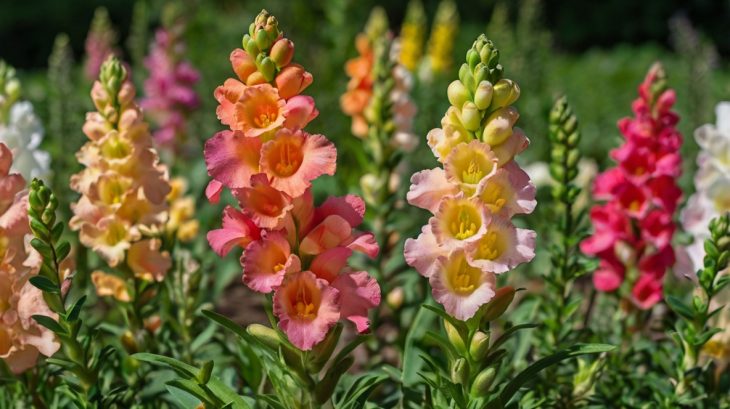
Snapdragons are more than just pretty flowers. These vibrant blooms, scientifically known as Antirrhinum majus, have a rich history and fascinating traits. Originating from the Mediterranean, snapdragons have been cherished for centuries. Their name comes from the flower’s unique shape, resembling a dragon’s mouth that “snaps” open when squeezed. Snapdragons come in a rainbow of colors, making them a favorite in gardens and floral arrangements. Beyond their beauty, these flowers have intriguing uses and meanings. For instance, in the language of flowers, snapdragons symbolize grace and strength. They also have a surprising role in science, particularly in genetics. Ready to learn more? Let’s dive into 19 captivating facts about these enchanting blooms!
Key Takeaways:
- Snapdragons, also known as Antirrhinum majus, are colorful flowers with a dragon-like appearance. They symbolize grace and strength, and can even self-seed in favorable conditions, making them a low-maintenance garden option.
- These unique flowers have practical uses beyond their beauty. They can be used as cut flowers, edible garnishes, and even have historical medicinal uses. Plus, they attract beneficial insects and deter pests in companion planting.
Snapdragon: A Fascinating Flower
Snapdragons are more than just pretty flowers. They have a rich history, unique characteristics, and interesting uses. Let’s dive into some amazing facts about these captivating blooms.
- Scientific Name: The scientific name for snapdragons is Antirrhinum majus. This name comes from Greek words meaning “like a nose.”
- Origin: Snapdragons originated in the Mediterranean region. They have been cultivated for centuries in Europe and North America.
- Name Origin: The name “snapdragon” comes from the flower’s resemblance to a dragon’s mouth. When squeezed, the flower “snaps” open and shut.
- Variety of Colors: Snapdragons come in a wide range of colors, including red, pink, yellow, orange, white, and even bi-colored varieties.
- Symbolism: In the language of flowers, snapdragons symbolize grace and strength. They can also represent deception due to their dragon-like appearance.
Growing Snapdragons
Snapdragons are popular in gardens due to their vibrant colors and ease of growth. Here are some interesting facts about growing these flowers.
- Annuals and Perennials: Depending on the climate, snapdragons can be grown as annuals or perennials. In warmer regions, they may survive year-round.
- Soil Preference: These flowers prefer well-drained soil with a neutral to slightly acidic pH. They thrive in rich, organic soil.
- Sunlight Needs: Snapdragons need full sun to partial shade. They bloom best with at least six hours of sunlight daily.
- Watering: While snapdragons need regular watering, they don’t like to be waterlogged. It’s important to keep the soil moist but not soggy.
- Temperature Tolerance: Snapdragons can tolerate cool temperatures and even light frosts. However, extreme heat can cause them to wilt.
Unique Characteristics
Snapdragons have some unique features that set them apart from other flowers. Let’s explore these fascinating traits.
- Dragon’s Mouth: The flower’s structure resembles a dragon’s mouth. When pinched, the “mouth” opens and closes, making it a fun plant for children.
- Fragrance: Some snapdragon varieties have a pleasant, mild fragrance. This makes them a popular choice for bouquets and floral arrangements.
- Height Variations: Snapdragons come in different heights, from dwarf varieties that grow just a few inches tall to taller types that can reach up to three feet.
- Pollinator Attraction: Snapdragons attract bees, butterflies, and hummingbirds. Their unique shape makes them a favorite among pollinators.
- Self-Seeding: In favorable conditions, snapdragons can self-seed. This means they can come back year after year without replanting.
Uses of Snapdragons
Beyond their beauty, snapdragons have practical uses in gardens and beyond. Here are some interesting applications.
- Cut Flowers: Snapdragons make excellent cut flowers. They have a long vase life and add vibrant color to floral arrangements.
- Edible Flowers: While not commonly eaten, snapdragon flowers are edible. They can be used as a garnish in salads and desserts.
- Medicinal Uses: Historically, snapdragons were used in traditional medicine. They were believed to have anti-inflammatory and diuretic properties.
- Companion Planting: Snapdragons can be used in companion planting. They help attract beneficial insects and can deter certain pests from other plants.
Final Thoughts on Snapdragon
Snapdragons are more than just pretty flowers. These vibrant blooms, known for their dragon-like appearance, have a rich history and unique characteristics. Originating from the Mediterranean, snapdragons have been used in traditional medicine and even as a natural dye. They come in a variety of colors, each with its own symbolism, making them a favorite in gardens and floral arrangements.
Snapdragons are also fascinating because of their ability to thrive in different climates. They can grow in both cool and warm weather, making them versatile for gardeners. Plus, their unique “mouth” opens and closes when squeezed, adding a playful element to their beauty.
Whether you’re a gardening enthusiast or just someone who appreciates nature’s wonders, snapdragons offer a blend of beauty, history, and fun. So next time you see these flowers, you’ll know there’s more to them than meets the eye.
Frequently Asked Questions
Was this page helpful?
Our commitment to delivering trustworthy and engaging content is at the heart of what we do. Each fact on our site is contributed by real users like you, bringing a wealth of diverse insights and information. To ensure the highest standards of accuracy and reliability, our dedicated editors meticulously review each submission. This process guarantees that the facts we share are not only fascinating but also credible. Trust in our commitment to quality and authenticity as you explore and learn with us.
